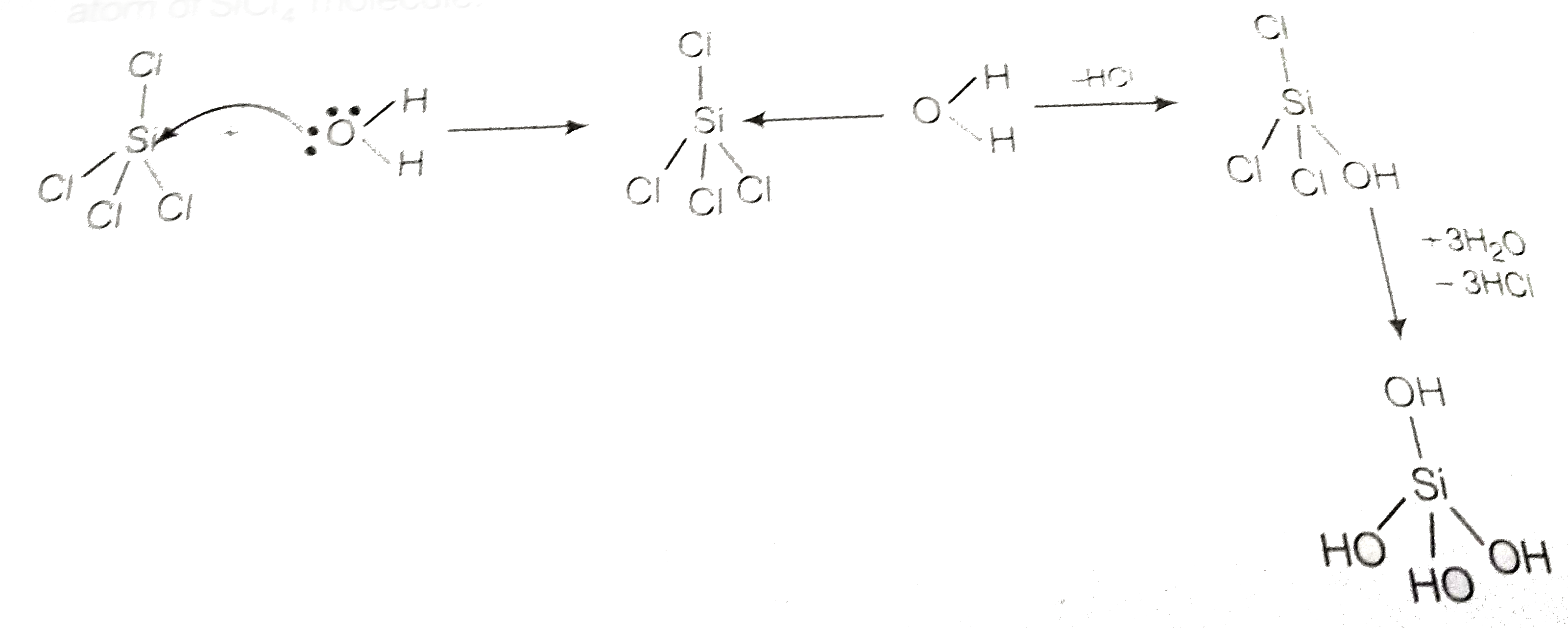Give reasons for the following
(a) is immiscible in water, whereas is easily hydrolysed.
(b) Carbon has a strong tendency for catenation compared to silicon.
(a) Carbon tetrachloride is a covalent compound while is a polar compound. does not form H-bond with water molecule. Hence, it is immiscible in water. Further more, is not hydrolysed by water because of the absence of d-orbitals in carbon while is readily hydrolysed by water.
The hydrolysis of occurs due to coordination of with empty 3d orbitals in silicon atom of molecule

(b) Carbon atoms have the tendency to link with one another through covalent bonds to form chains and rings. This property is called catenation. This property is called catenation. This is because C-C bonds are very strong
Down the group, the size increases and electronegativity decreases and thereby, tendency to show catenation decreases. Thus, carbon has a strong tendency for catenation as compared to silicon.
Topper's Solved these Questions
- BOOK - NCERT EXEMPLAR ENGLISHCHAPTER - THE P-BLOCK ELEMENTSEXERCISE - Matching3videos
THE P-BLOCK ELEMENTS
- BOOK - NCERT EXEMPLAR ENGLISHCHAPTER - THE P-BLOCK ELEMENTSEXERCISE - Assertion and Reason2videos
THE P-BLOCK ELEMENTS
- BOOK - NCERT EXEMPLAR ENGLISHCHAPTER - THE P-BLOCK ELEMENTSEXERCISE - Long Answer9videos
THE P-BLOCK ELEMENTS
- BOOK - NCERT EXEMPLAR ENGLISHCHAPTER - STRUCTURE OF ATOMEXERCISE - All Questions55videos
STRUCTURE OF ATOM
- BOOK - NCERT EXEMPLAR ENGLISHCHAPTER - THE S-BLOCK ELEMENTS EXERCISE - Long Answer Type Questions8videos
THE S-BLOCK ELEMENTS
Similar Questions
Explain giving reasons the following:
CCl4 is not hydrolysed with water but SiCl4 is easily hydrolysed.View SolutionCCl4 is inert towards hydrolysis but SiCl4 is readily hydrolysed because
View SolutionCCl4 does not show hydrolysis but SiCl4 is readily hydrolysed because:
View SolutionGive reasons for the following observations :
Why SF4 undergoes hydrolysis but not SF6?
Or SF6 is inert towards hydroysis.
SF6 is much less reactive than SF4.
Or (i) SF4 is easily hydrolysed whereas SF6 is not easily hydrolysed.
(ii) Sulpher exhibits greater tendency for calenation than selenium.
(iii) Sulpher has a higher tendency for catenation than oxygen.View SolutionState reasons for each of the following :
(i) All the P-Cl bonds in PCl5 molecule are not equivalent.
(ii) Sulphur has greater tendency for catenation than oxygen.View SolutionAssertion (A) : CCl4 is inert towards hydrolysis but SiCl4 is readily hyrolyse .
Reason (R) : Carbon cannot expand its octet but silicon can expand its octet .View Solution(a) Account for the following observations :
(i) SF4 is easily hydrolysed whereas SF6 is not easily hydrolysed.
(ii) Chlorine water is a powerful bleaching agent.
(iii) Bi (V) is a stronger oxidising agent than Sb(V)
(b) What happens when :
(i) White phosphorus is heated with concentrated NaOH solution in an inert atmosphere of CO2.
(ii) XeF6 undergoes partial hydrolysis.
(Give the chemical equations involved).View SolutionWhy is SiCl4 readily hydrolysed but CCl4 is resistant to hydrolysis?
View SolutionExplain the following situations :
(i) In the structure of HNO3 molecule , the N-O bond (121 pm) is shorter than N-OH bond (140pm).
(ii) SF4 is easily hydrolysed whereas SF6 is not easily hydrolysed.
(iii) XeF2 has a straight linear structure and not a bent angular structure.View SolutionDraw the structures of the following :
(i) H2S2O8
(ii) HClO4
(b) How would you account for the following :
(i) NH3 is a stronger base than PH3.
(ii) Sulphur has a greater tendency for catenation than oxygen.
(iii) F2 is stronger oxidising agent than Cl2.View Solution

